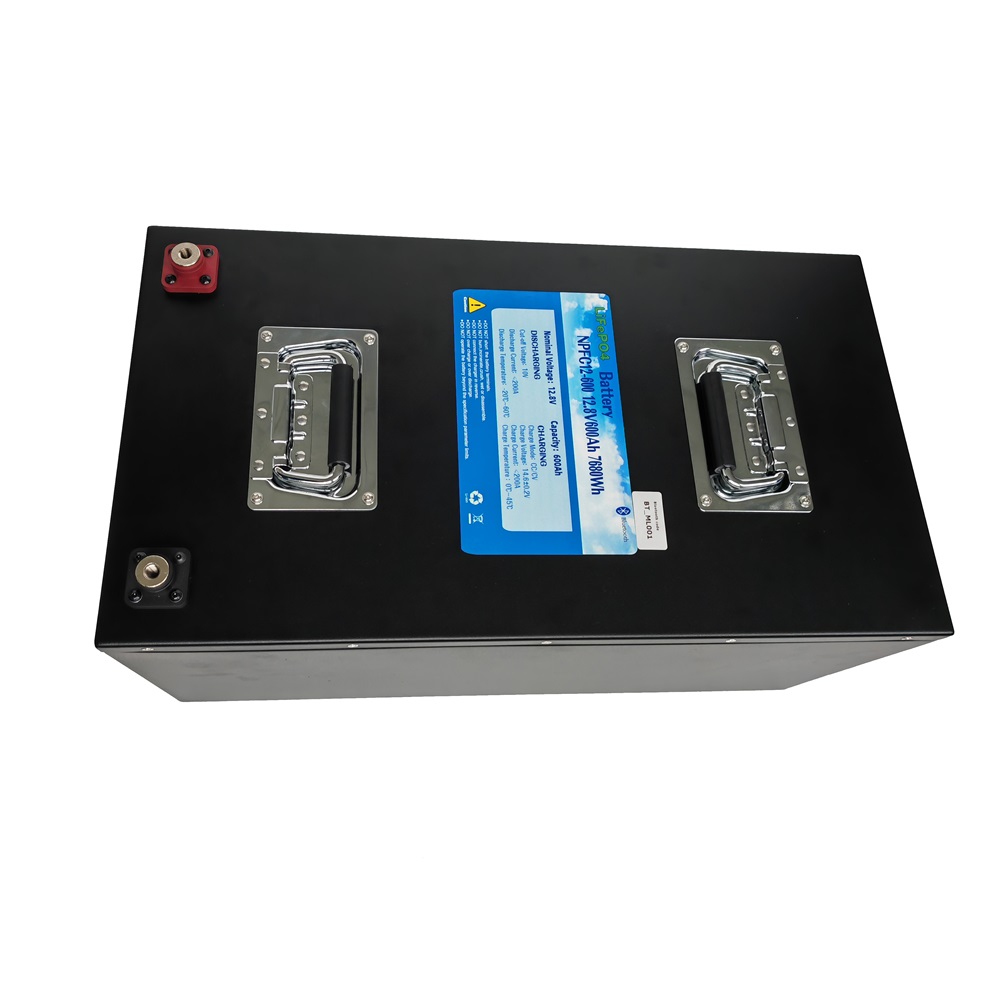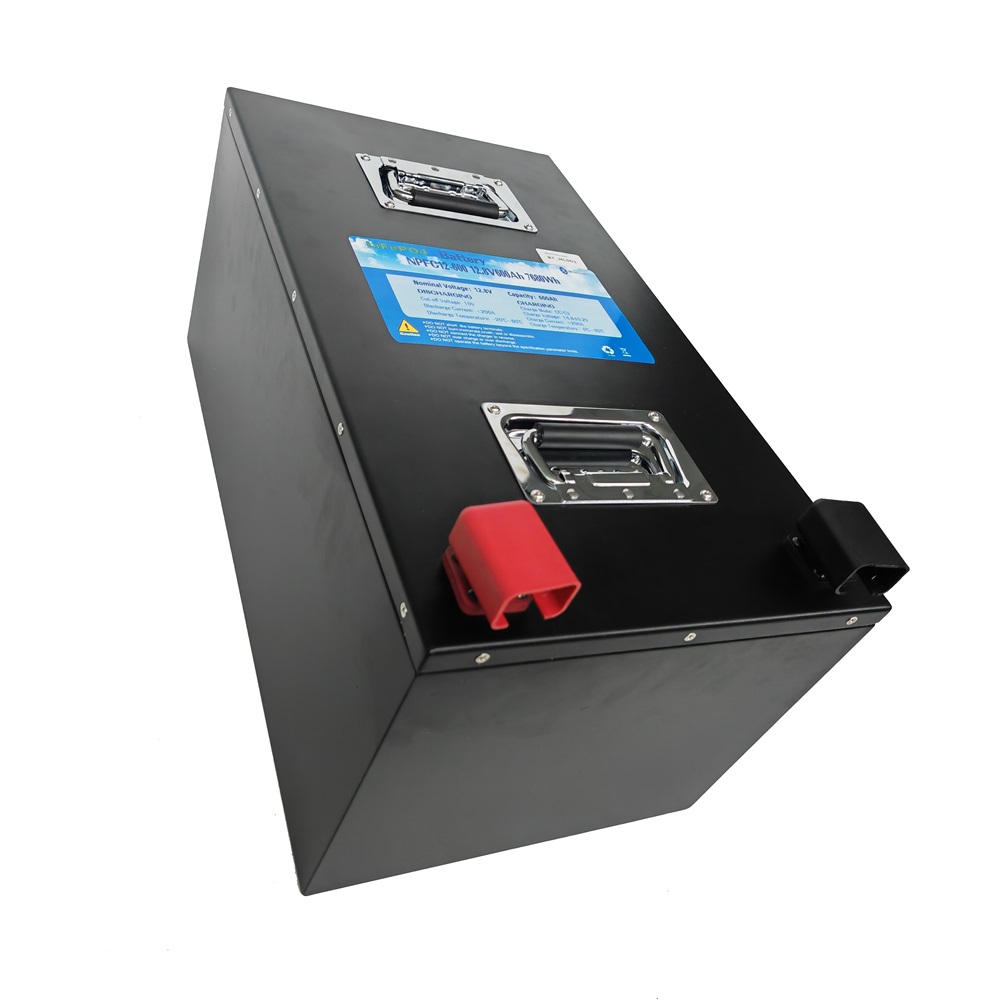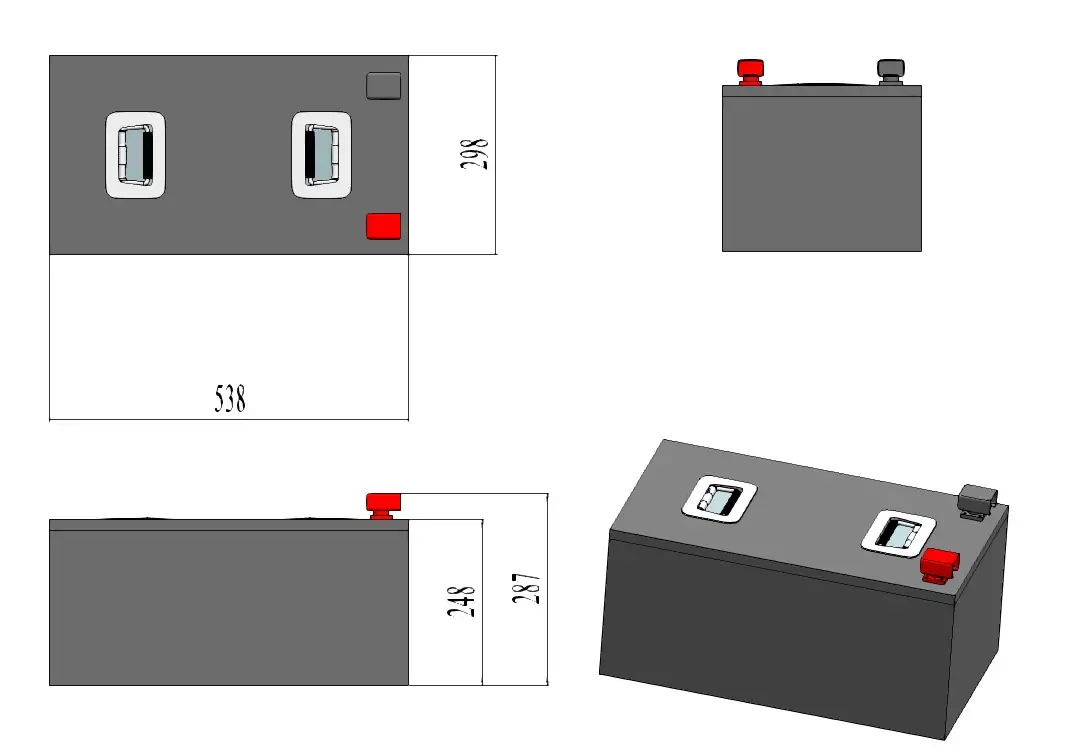 |
Welcome To Evlithium Best Store For Lithium Iron Phosphate (LiFePO4) Battery |
 |
Individual pricing for large scale projects and wholesale demands is available.
Mobile/WhatsApp/Wechat: +86 156 0637 1958
Email: info@evlithium.com
Customized 12v 600ah 7.2kwh lifepo4 battery pack with smart bms for energy storage, rv, etc..
|
Items |
Parameter |
|
Product Model |
NPFC12-600 |
|
Normal Voltage |
12.8V |
|
Rated Capacity |
600Ah |
|
Energy |
7680Wh |
|
Charge Voltage |
14.6±0.2V |
|
Cutoff Voltage |
About 10V |
|
Charge Current |
≤200A |
|
Discharge Current |
≤200A |
|
Operating Temperature Range |
Charge:0℃-45℃ |
|
Discharge: -20℃-60℃ |
|
|
Storage |
Best: 0~ 40℃ ,20 %-60 % capacity |
|
Output Terminal |
M8 |
|
Dimensions |
(538±2) mm *(298±2) mm *(248±2) mm |
|
Cycle time |
2000 times |
|
Weight |
About 66kg |
|
Shell material |
Metal: Stainless steel baking paint |
|
Color |
Black |
|
IP |
IP65 |
|
BMS |
4S200A Software board, With Bluetooth Over charge protection, Over-discharge protection, Temperature protection, Short-circuit protection, Balanced function |
|
Cell and Combination mode |
2670-4Ah-3.2V, 150P4S |



Battery Usage Guide
3.1 Charge
Charging terminal of battery is connected to charger appropriate with it, and then charge. Charging voltage is 14.6±0.2V. Do not reverse.
3.2 Discharge
Note that the positive and negative (poles are not reversed as indicated by the battery case logo), then connect to the matching load.
4. Battery Test
Single cell and Protection board specification are only results of standard test, this is for reference.
4.1 Standard Test Requirements
All tests in this specification should be done in standard atmospheric conditions. (Temperature: 25± 2℃; relative humidity:65± 20%).
Standard charge voltage is 14.6±0.2V, standard discharge cutoff voltage is about 10V; standard current is I2 (when I2 > the normal work current, test according to the normal current).
4.2 Standard Charge
Charge the battery with Lithium ion battery special test cabinet, with standard charging voltage, standard current, constant current and constant voltage charging to the current dropping to 0.05 I5·
4.3 Standard Discharge
Discharge the battery with Lithium ion battery special test cabinet, discharge to standard discharge cutoff voltage with standard current, constant discharging or until the battery stops.
5 Battery Use Environment Requirements
Battery discharge ambient temperature is -20 ℃~ + 60 ℃ (When the ambient temperature >45℃, please pay attention to the ventilation and heat dissipation), Charging temperature is 0 ℃~ + 45 ℃. Ambient humidity RH is ≦ 85%. Pay attention to waterproof when ambient humidity is > 85%, at the same time the battery surface condensation phenomenon should be avoided.
6 Special Attentions
In order to make full use of the energy efficiency of the battery and prevent accidents such as leakage or heat generation, please prohibit the followings:
◆Do not immerse the battery in the water. Once it is in the water, isolate it immediately and ask a professional to deal with it.
◆Do not charge, discharge and leave the battery at temperatures over 60℃. Also keep away from fire, heater or corrosive materials. Otherwise, it can cause overheat, fire, or function failure, shortened life, or even danger happening.
◆Do not charge the battery at temperature below 0℃.
◆Do not reverse the positive and negative terminals. Do not short the positive and negative of the battery.
◆Do not combine the battery in series or in parallel.
◆Do not reverse polarity charging. Do not connect the battery electrodes to an electrical outlet.
◆Do not transport or store the battery together with metal objects such as hairpins, necklaces, etc.
◆Do not strike, trample, throw, fall and shock the battery.
◆Do not directly weld the battery and pierce the battery with a nail or other sharp objects.
◆Do not use the battery in the location where static electricity and magnetic field is strong. Otherwise the battery protection circuit may be damaged.
◆Do not overload the battery.
◆Do not machine the circuit board, which may damage the internal circuit and cause function failure.
◆Do not deform the product under pressure, which may cause electronic components or part of the circuit damage, and make the product unstable.
◆Do not remove the case, in case of unnecessary damage.
◆Do not overcharge or over discharge the battery.
◆Please use special charger for charging.
◆Please charge the battery within 12 hours after using. If the battery is not charged for more than 12 hours after using, please test the battery voltage before charging. If the voltage of the battery is <10V, do not charge, need to place in isolation.
◆If the battery leaks and liquid splashes into the eyes or skin, do not rub, wash it with clean water, and immediately seek medical attention.
◆In case of accidental fire, dry powder fire extinguisher or sand should be used.
◆If the battery gives off strange odor, generates heat, becomes discolored or deformed, or any abnormality appears during use, storage, or charging, stop charging and using immediately, remove and isolate it from the device in the safe way.
◆The electrode of the discarded battery terminal should be covered with insulating paper to reduce the safety hazard when laying aside.
◆Reversing the Positive and negative charging terminal will burn the internal circuit board, so pay attention to it.
7 Battery Using and Maintenance
7.1 Battery Storage
Storage temperature 0℃~40℃(Optimum storage temperature 15℃~25℃, dry preservation). Battery performance is affected by temperature, the most obvious is the change in battery capacity, this is normal phenomenon. Avoid condensation caused by temperature changes during storage, otherwise it will lead to the rust of batteries or metal parts.
7.2 Battery Checking Before Using
◆After receiving the battery, first check the packing carefully, please ensure there’s no shock on the battery during the handling process.
◆Please check the battery case and accessories if there’s any damage or leakage, if so, please contact us immediately.
Please check the output connector is correct or not, measure whether the positive and negative is reversed and whether the voltage is within the normal standard. In case the battery terminals are dirty or rust, clean the terminals with a dry cloth .
◆before use. Otherwise poor performance may occur due to the poor connection with the instrument.
7.3 Battery Installation Notes
◆Please clean up the installation position of the battery to ensure no dust, metal or other foreign materials. No smoking or fire during installation to avoid short-circuit of battery and prevent equipment damage or personal injury.
◆The battery should be installed under the condition with well-ventilated and no sunlight. Don’t put it under place with possible flooding. The using and storage of the battery should be kept away from inflammable and explosive materials
◆When fastening battery terminals, please don’t use excessive force, or the terminals could be damaged.
◆After installation, please check whether the terminal fastening is in place and whether there are sundries on the surface of the battery. Clean the surface of battery with dry cloth, please don’t use oil or other volatile organic solvents to clean, or it may damage it.
◆Please make sure that the positive (+) & negative (-) polarity is correctly connected, or it may fire or damage the battery and electrical appliances.
◆Test to run the equipment, observe whether the equipment and battery are abnormal.
7.4 Battery Working Requirements
◆The charge and discharge current of the battery shall not exceed the specified maximum charge and discharge current, which may affect the service life of the battery or damage the internal circuit, or even cause danger.
◆Discharge current shall not exceed the specified maximum discharge current, which may affect the service life of the battery or damage the internal circuit.
◆When the battery is short of power, it should be charged in time, which is beneficial to extend the battery life. If the battery is not charged in time, battery is in the state of power shortage for a long time, battery life will be affected
◆The lithium-ion battery charge and discharge shallow is beneficial to improve the cycle life. Suggest user each discharge be put to about 80% of the nominal capacity.
7.5 Battery Using and Maintenance
The battery would be possible to be at the over-discharged state by its self-discharge characteristics in case the battery is not used for long time. In order to prevent over-discharging, the battery shall be charged periodically to maintain a certain voltage range:13V-14V, 2 months one cycle. ( for battery with communication function, please maintain it once in 1 month) What's more, the SOC/capacity.
Packing details

All Rights reserved © 2025 Evlithium Limited